The Ultimate Guide to Interior Design Restaurant: Creating Unforgettable Dining Experiences
In the competitive world of hospitality, interior design restaurant plays a pivotal role in attracting customers and creating memorable dining experiences. From the moment patrons step through the door, every element of the restaurant’s interior design contributes to their overall impression and enjoyment. This comprehensive guide explores the intricate world of interior design restaurant, offering insights, trends, and practical advice for restaurateurs, designers, and food enthusiasts alike.
Understanding the Importance of Interior Design Restaurant
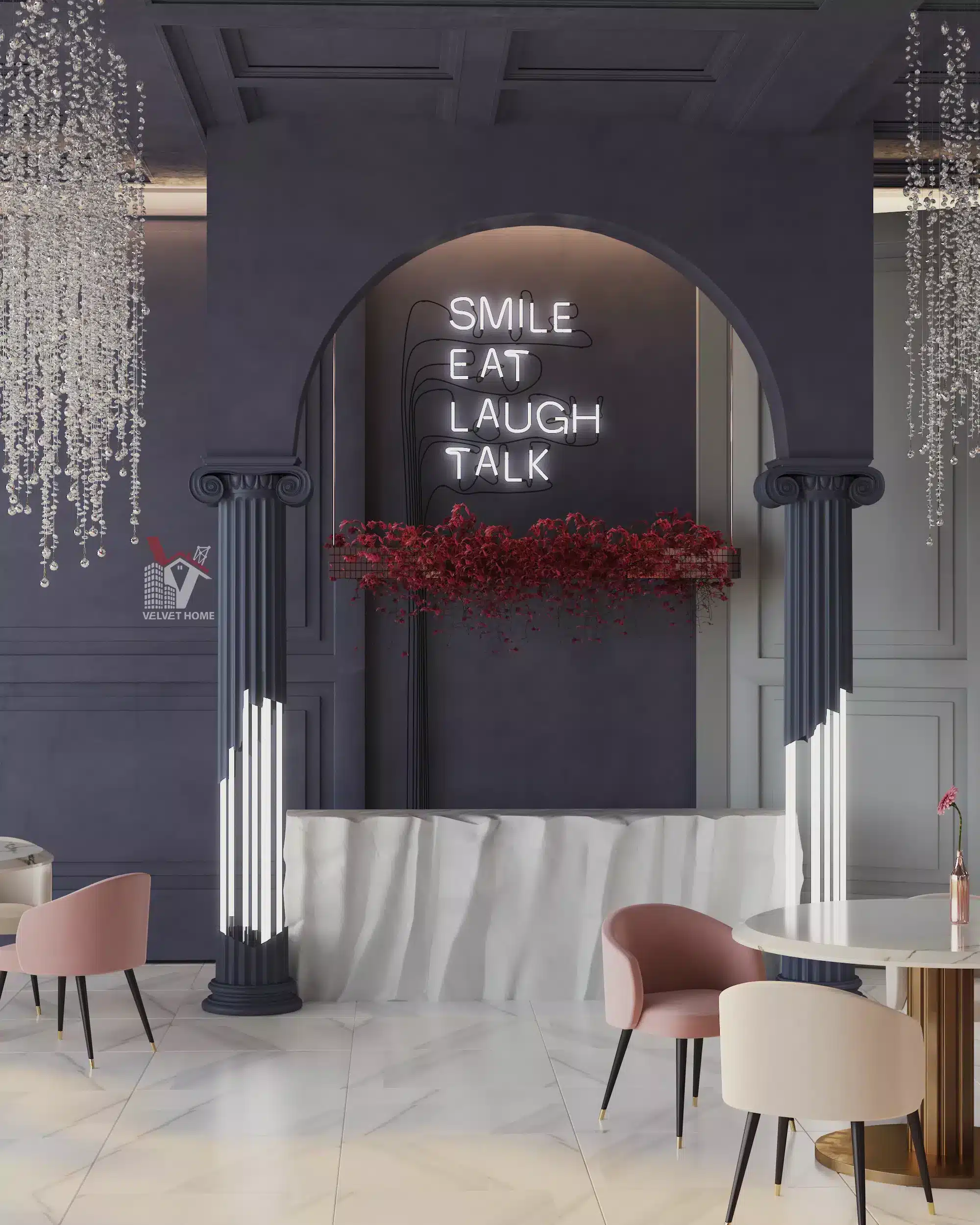
Interior design restaurant goes far beyond mere aesthetics. It’s a carefully crafted blend of functionality, ambiance, and brand identity that can make or break a dining establishment. A well-executed restaurants interior design not only attracts customers but also enhances their dining experience, encourages them to stay longer, and ultimately drives repeat business.
The Psychology of Restaurant Design Interior
The psychology behind restaurant design interior is a fascinating aspect that savvy restaurateurs leverage to their advantage. Colors, lighting, seating arrangements, and even the placement of decorative elements can significantly influence diners’ moods, perceptions, and behaviors. For instance, warm colors like reds and oranges are known to stimulate appetite, while cool blues and greens can create a calming atmosphere.
First Impressions Matter in restaurants interior design
The entrance and reception area of a restaurant set the tone for the entire dining experience. This is where restaurant interior decor becomes crucial in creating a welcoming and enticing atmosphere. From the signage and door design to the host stand and waiting area, every detail contributes to the guest’s first impression.
Key Elements of Successful Interior Design Restaurant
Creating a successful interior design restaurant requires careful consideration of several key elements. Let’s explore these components in detail:
1. Layout and Space Planning in Restaurant Designs Interior
The layout is the foundation of any restaurant design interior. It determines the flow of both staff and customers, impacts the efficiency of service, and influences the overall dining experience. Key considerations include:
- Traffic flow patterns
- Seating capacity and arrangement
- Kitchen and service area accessibility
- Bar placement (if applicable)
- Restroom locations
A well-planned layout maximizes space utilization while ensuring comfort for diners and efficiency for staff.
2. Lighting Design in restaurants interior design
Lighting is a critical element in restaurants interior design. It not only affects the ambiance but also plays a role in food presentation and customer comfort. Consider:
- Natural light utilization
- Task lighting for functional areas
- Ambient lighting for atmosphere
- Accent lighting to highlight design features or artwork
The right lighting scheme can transform the mood of a space from intimate and cozy to vibrant and energetic.
To learn more we advise you to read our article about Light Design in Home: Expert Tips and Strategies
3. Color Palette and Materials in restaurants interior design
The choice of colors and materials in restaurants interior design significantly impacts the overall aesthetic and atmosphere. Consider:
- Color psychology and its effect on appetite and mood
- Durability and maintenance of materials
- Consistency with brand identity
- Textures and finishes that complement the concept
4. Furniture Selection for Restaurant Interiors Decor
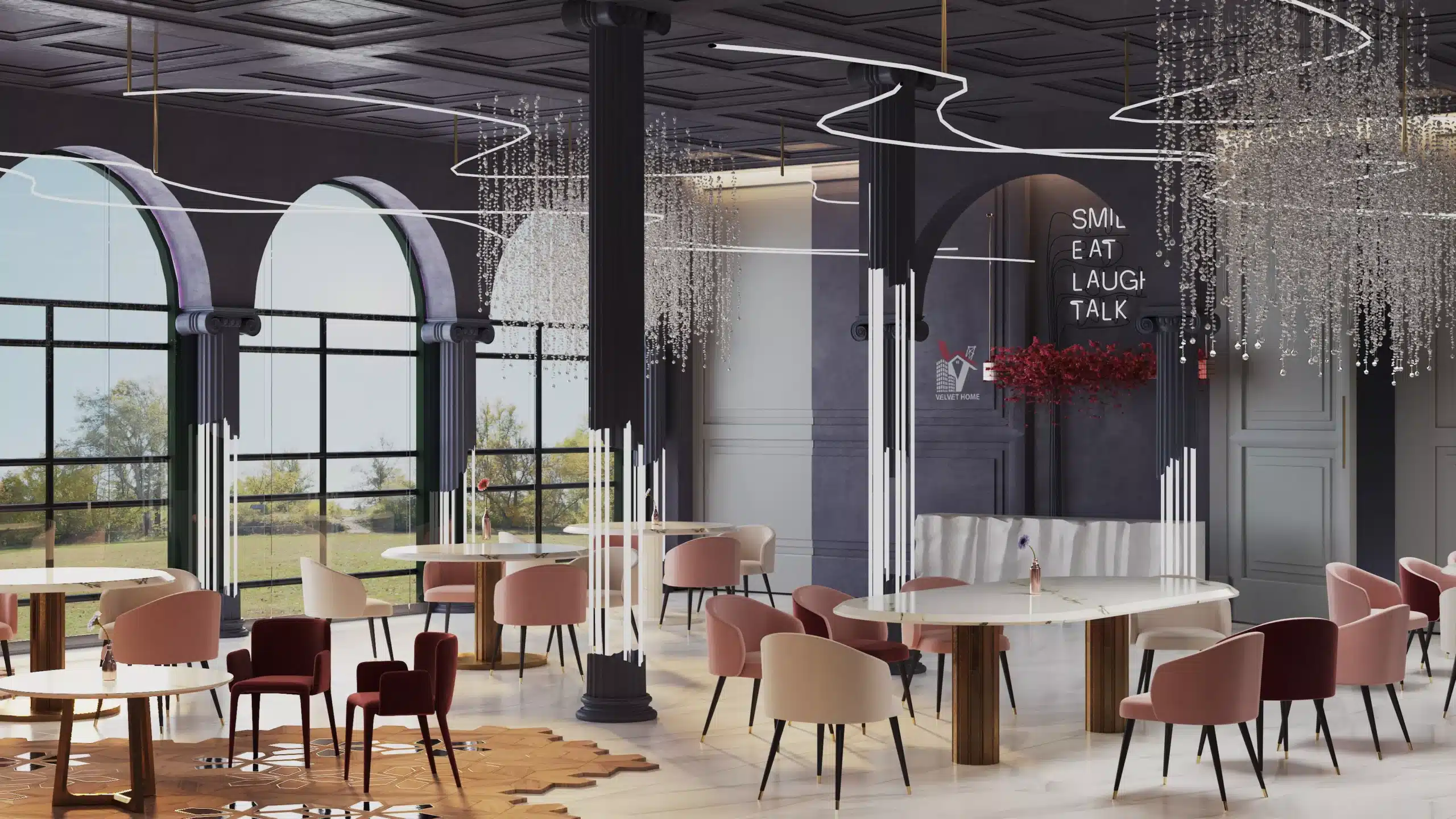
Furniture is not just about providing seating; it’s an integral part of the restaurant’s interior decor and functionality. Key factors include:
- Comfort and ergonomics
- Style consistency with the overall design theme
- Durability and ease of maintenance
- Flexibility for different group sizes
5. Acoustics in Restaurant Designs Interior
Often overlooked, acoustics play a crucial role in the dining experience. Poor acoustics can lead to a noisy environment that detracts from the overall experience. Consider:
- Sound-absorbing materials
- Strategic placement of noise-generating areas
- Background music systems
6. Brand Integration in restaurants interior design
Successful restaurants interior design seamlessly integrates the brand’s identity and story into the physical space. This can be achieved through:
- Custom artwork or installations
- Exclusive Design Elements that Embody Brand Values
- Consistent use of logo and brand colors
Trends in restaurant interior designs
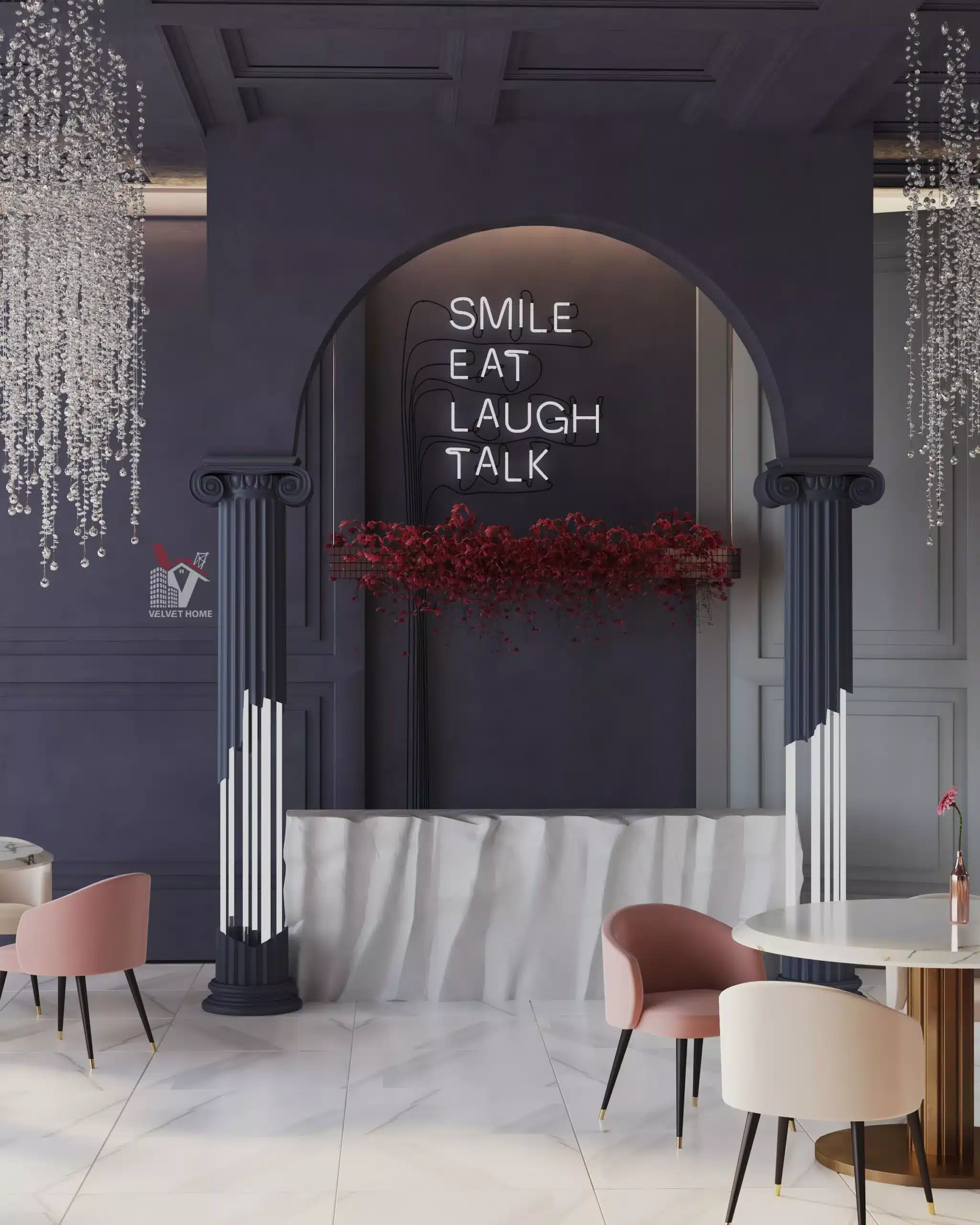
The world of restaurant interior designs is constantly evolving. Staying abreast of current trends can help create a contemporary and appealing space. Some notable trends include:
1. Biophilic Design in restaurants interior design
Incorporating natural elements into restaurant interiors has gained significant popularity. This trend involves:
- Living walls or vertical gardens
- Abundant use of plants
- Natural materials like wood and stone
- Large windows to bring the outdoors in
2. Sustainable and Eco-Friendly Restaurant Designs Interior
With increasing environmental awareness, many restaurants are adopting sustainable design practices:
- Use of recycled or upcycled materials
- Energy-efficient lighting and appliances
- Water-saving fixtures
- Locally sourced materials and furnishings
3. Open Kitchens in restaurants interior design
Open kitchen designs have become increasingly popular, offering transparency and entertainment value:
- Visible food preparation areas
- Chef’s tables or counter seating
- Integration of kitchen into the overall design scheme
4. Multifunctional Spaces in restaurants interior design
Flexible designs that can adapt to different needs throughout the day are on the rise:
- Convertible dining areas
- Spaces that transition from day to night use
- Modular furniture for easy reconfiguration
5. Technology Integration in Restaurant Designs Interior
Modern restaurant designs interior often incorporates technology seamlessly:
- Digital menus and ordering systems
- Smart lighting and climate control
- Interactive elements for customer engagement
Designing for Different Restaurant Concepts
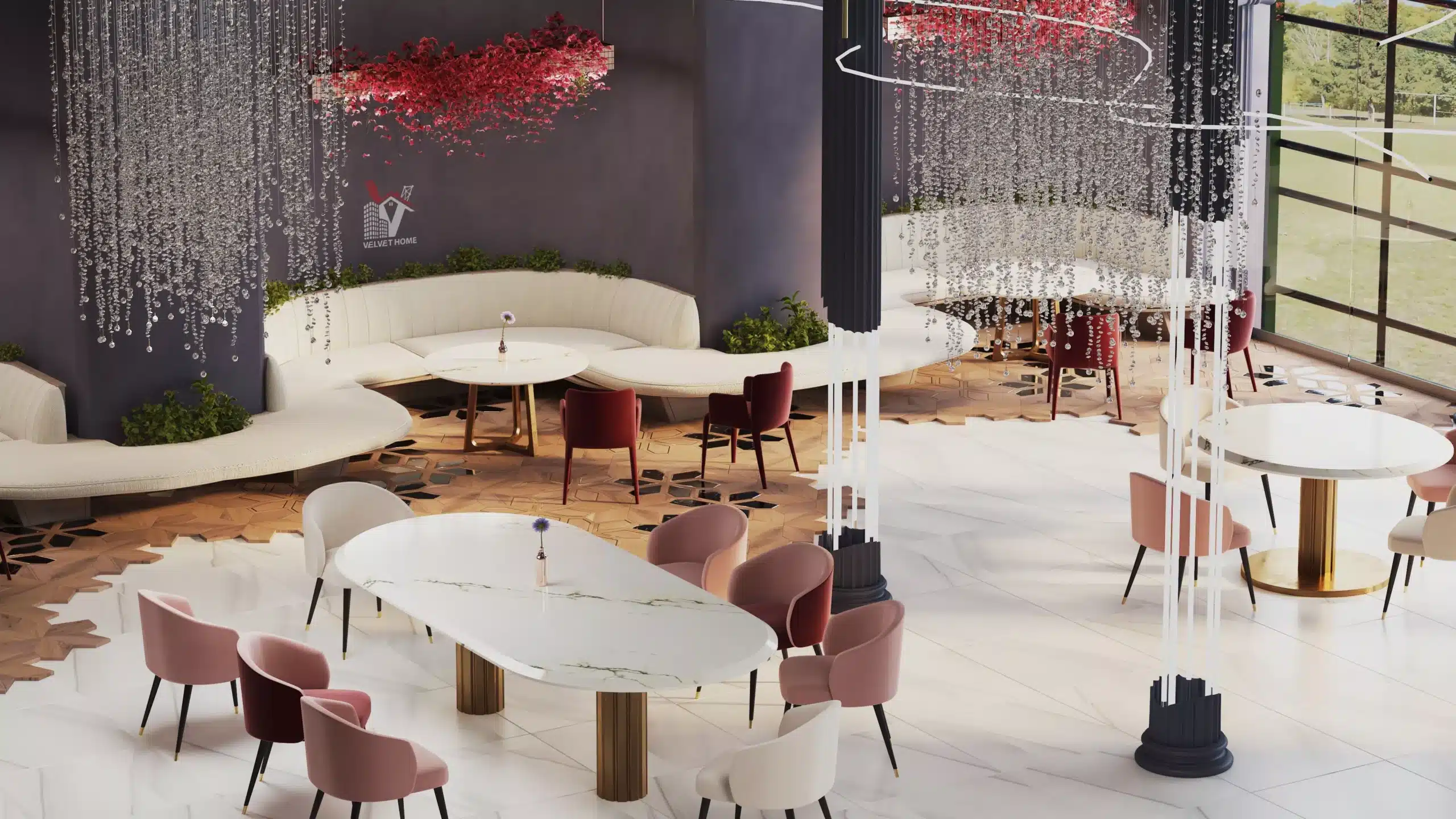
Interior design for restaurants varies greatly depending on the concept and cuisine. Let’s explore how design elements can be tailored to different restaurant types:
Fine Dining Establishments
Fine dining restaurants often focus on creating an atmosphere of luxury and sophistication. Key design elements might include:
- Elegant lighting fixtures
- High-quality, comfortable seating
- Fine linens and tableware
- Artwork and custom installations
- Intimate seating arrangements
Casual Dining Restaurants
Casual dining spaces aim for a relaxed, welcoming atmosphere. Design considerations might include:
- Warm color palettes
- Comfortable, durable furniture
- Open floor plans
- Playful or themed decor elements
- Family-friendly seating options
Fast-Casual Concepts
Fast-casual restaurants blend quick service with a more upscale ambiance. Design elements often include:
- Efficient queuing and ordering areas
- Mix of seating options (high-tops, booths, communal tables)
- Brand-centric graphics and signage
- Easy-to-clean surfaces and materials
Themed Restaurants
Themed restaurants require a cohesive design that immerses diners in a specific concept or era. This might involve:
- Custom props and decorations
- Themed lighting and music
- Staff uniforms that match the theme
- Unique architectural elements
The Role of Branding in Interior Design Restaurant
A restaurant’s interior design should be an extension of its brand identity. This cohesion helps create a memorable experience and builds brand recognition. Consider the following:
1. Color Scheme
Use the brand’s color palette strategically throughout the space, from wall colors to upholstery and accent pieces.
2. Logo Integration
Incorporate the restaurant’s logo in creative ways, such as custom light fixtures, wall art, or even subtly in floor patterns.
3. Storytelling Through Design
Use design elements to tell the restaurant’s story or showcase its values. This could include historical photographs, locally sourced materials, or artwork that reflects the cuisine’s origin.
4. Consistent Touchpoints
Ensure that all customer touchpoints, from menus to napkins, align with the overall design aesthetic.
Practical Considerations for Interior Design Restaurant
While aesthetics are important, practical considerations are equally crucial in restaurants interior design:
1. Durability and Maintenance
Premium, Resilient Materials Handpicked, elite-grade finishes that merge timeless durability with effortless maintenance, ensuring enduring sophistication.
2. Accessibility
Ensure the design complies with accessibility standards, providing comfortable access for all patrons.
3. Safety Regulations
Adhere to local safety codes and regulations, particularly regarding fire safety and emergency exits.
4. Energy Efficiency
Incorporate energy-efficient design elements to reduce operational costs and environmental impact.
5. Flexibility
Design with future changes in mind, allowing for easy updates or reconfigurations as needed.
The Design Process of restaurant interior design
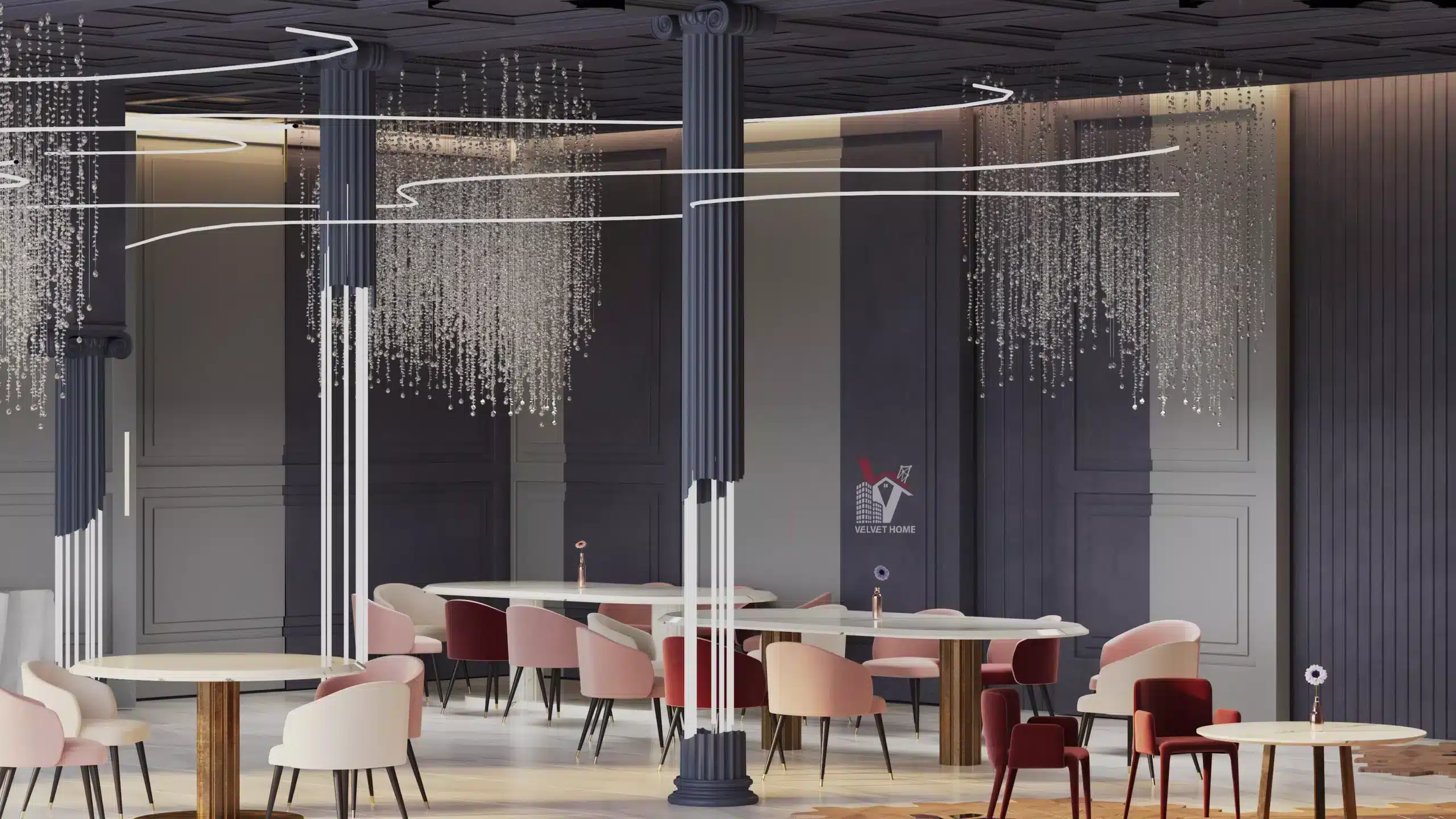
Creating a successful restaurant interior design involves a structured process:
- Conceptualization: Develop the initial design concept based on the restaurant’s brand, cuisine, and target audience.
- Space Planning: Create detailed floor plans and layout designs.
- Material and Color Selection: Choose materials, finishes, and color schemes that align with the concept.
- Lighting Design: Develop a comprehensive lighting plan.
- Furniture and Fixture Selection: Choose appropriate furniture, fixtures, and equipment.
- Custom Element Design: Create any custom pieces or installations.
- Construction Documents: Prepare detailed plans for contractors.
- Project Management: Oversee the implementation of the design.
- Final Touches: Add decorative elements and finalize the space.
The Impact of Technology on Interior Design Restaurant
In the digital age, technology is increasingly integrated into restaurant interiors design:
1. Digital Menus and Ordering Systems
Touchscreen menus and self-ordering kiosks can be seamlessly incorporated into the design.
2. Smart Lighting Systems
Programmable LED lighting systems allow for dynamic ambiance changes throughout the day.
3. Interactive Experiences
Augmented reality elements or interactive tables can add a unique dimension to the dining experience.
4. Social Media-Friendly Spaces
Creating “Instagrammable” moments or photo opportunities within the design can boost social media presence.
Sustainability in Interior Design Restaurant
As environmental concerns grow, sustainable design practices are becoming increasingly important in restaurant interiors design:
1. Energy-Efficient Lighting
State-of-the-Art Energy Management Cutting-edge LED illumination paired with intelligent control systems, delivering unparalleled energy efficiency while creating an atmosphere of refined ambiance.
2. Sustainable Materials
Use of recycled, reclaimed, or sustainably sourced materials for furniture and finishes.
3. Water Conservation
Eco-Luxe Water Solutions Bespoke water-conservation fixtures that harmonize sustainable luxury with exceptional performance in both culinary and lavatory spaces.
4. Waste Reduction
Designing spaces that facilitate recycling and composting.
5. Local Sourcing
Using locally sourced materials and working with local artisans reduces transportation emissions and supports the local economy.
Case Studies: Successful Interior Design Restaurant Projects
Examining successful restaurants interior design projects can provide valuable insights and inspiration:
Case Study 1: The Green Oasis
This farm-to-table restaurant in Dubai successfully integrated biophilic design principles:
- Living wall features throughout the dining area
- Greenhouse-inspired glass ceiling
- Reclaimed wood furniture
- Open kitchen with herb garden display
Case Study 2: Retro Diner Deluxe
A nostalgic American diner concept in Abu Dhabi that blends retro charm with modern comfort:
- Chrome and neon accents
- Custom-designed booth seating
- Vintage-inspired light fixtures
- Jukebox and other period-appropriate decorative elements
Case Study 3: Fusion Fine Dining
An upscale fusion restaurant in Sharjah that seamlessly blends cultural influences:
- Traditional Middle Eastern patterns in modern applications
- Custom light installations inspired by Asian lanterns
- Open kitchen with chef’s table
- Luxurious materials like marble and velvet
The Future of Interior Design Restaurant
As we look to the future, several trends are likely to shape restaurants interior design:
1. Increased Focus on Health and Hygiene
Post-pandemic designs may incorporate more touchless technologies and easy-to-clean surfaces.
2. Virtual and Augmented Reality Experiences
Integration of VR and AR technologies to enhance the dining experience or provide virtual dining options.
3. Adaptive and Transformable Spaces
Designs that can quickly adapt to different needs or even transform for various meal services.
4. Hyper-Personalization
Use of data and technology to create personalized dining environments for individual customers.
5. Biophilic Design Evolution
Continued integration of nature, potentially including on-site hydroponic gardens or aquaponic systems.
Frequently Asked Questions About Interior Design Restaurant
To provide further insight into restaurant interiors design, especially in the context of the UAE market, here are some common questions and their answers:
Q1: How does interior design restaurant impact customer experience?
A: restaurant interiors design significantly impacts customer experience by creating the overall ambiance, influencing mood, and affecting comfort levels. A well-designed interior can enhance the dining experience, encourage longer stays, and increase the likelihood of return visits. Elements like lighting, color scheme, seating comfort, and spatial layout all contribute to how customers perceive and enjoy their time in the restaurant.
Q2: What are the key trends in restaurant interior design in the UAE?
A: Some key trends in restaurants interior design in the UAE include:
- Incorporation of local cultural elements and materials
- Biophilic design with abundant use of plants and natural materials
- Open kitchen concepts for transparency and entertainment
- Smart technology integration for enhanced dining experiences
- Sustainable and eco-friendly design practices
- Luxurious and opulent interiors, especially in fine dining establishments
- Instagram-worthy spaces and features for social media promotion
Q3: How can restaurant owners in the UAE ensure their interior design stands out?
A: To create a standout restaurant interiors design in the UAE:
- Incorporate unique, locally-inspired elements that reflect Emirati culture and heritage
- Invest in high-quality, custom-made furniture and fixtures
- Create a strong brand identity and ensure it’s reflected consistently throughout the design
- Utilize innovative lighting techniques to create memorable ambiances
- Consider incorporating interactive or tech-driven elements for a modern touch
- Collaborate with renowned local or international designers for a fresh perspective
- Focus on creating ‘Instagrammable’ spots within the restaurant
Q4: What are some common mistakes to avoid in restaurants interior design?
A: Common mistakes to avoid in restaurants interior design include:
- Overcrowding the space with too many tables or decorative elements
- Neglecting proper lighting design
- Choosing style over comfort in seating options
- Ignoring acoustics, leading to a noisy environment
- Failing to consider the flow of both customers and staff
- Neglecting storage needs and back-of-house areas
- Not aligning the design with the restaurant’s concept and target audience
Q5: How important is it to hire a professional for interior design restaurant projects in the UAE?
A: Hiring a professional for design restaurant projects in the UAE is crucial. They bring expertise in local regulations, cultural sensitivities, and market trends. Professional designers can:
- Optimize space utilization and flow
- Ensure compliance with local building codes and regulations
- Create a cohesive design that aligns with your brand and concept
- Manage budgets effectively and potentially save costs in the long run
- Bring innovative ideas and access to unique materials and furnishings
- Handle project management, reducing stress for restaurant owners
- Create a design that stands out in the competitive UAE restaurant scene
Q6: How can sustainable practices be incorporated into interior design restaurant in the UAE?
A: Sustainable practices in interior design restaurant for the UAE can include:
- Using energy-efficient lighting and appliances
- Incorporating recycled or upcycled materials in furniture and decor
- Implementing water-saving fixtures in restrooms and kitchens
- Utilizing local and sustainable materials to reduce carbon footprint
- Designing for natural light and ventilation to reduce energy consumption
- Creating spaces that facilitate recycling and composting
- Using low-VOC paints and finishes for better indoor air quality
Q7: What role does technology play in modern interior design restaurant in the UAE?
A: Technology plays a significant role in modern design restaurant in the UAE:
- Digital menus and ordering systems can be integrated into the decor
- Smart lighting systems can create dynamic ambiances
- Interactive tables or walls can provide unique dining experiences
- HVAC systems can be optimized for comfort and energy efficiency
- Sound systems can be discreetly incorporated for perfect acoustics
- Charging stations and Wi-Fi can be seamlessly integrated into the design
- AR and VR technologies can be used to create immersive dining experiences
Conclusion: The Art of Creating Unforgettable Dining Spaces
design restaurant is a complex and multifaceted discipline that requires a deep understanding of aesthetics, functionality, and human psychology. By carefully considering all aspects of design, from layout and lighting to materials and branding, restaurateurs and designers can create spaces that not only look beautiful but also enhance the overall dining experience.
As the industry continues to evolve, staying informed about current trends and emerging technologies will be crucial for creating innovative and successful restaurant designs. Whether it’s a cozy cafe, a bustling bistro, or an elegant fine dining establishment, thoughtful design restaurant has the power to transform a simple meal into an unforgettable experience.
Velvet Home: Elevating restaurants interior design in the UAE
When it comes to creating exceptional restaurants interior designs in the UAE, Velvet Home stands out as a leader in the field. With a deep understanding of local tastes and global trends, Velvet Home brings a unique perspective to every project.
Their team of experienced designers specializes in crafting bespoke restaurant interiors that perfectly balance aesthetics, functionality, and brand identity. From concept development to final execution, Velvet Home offers comprehensive design services tailored to each client’s specific needs and vision.
What sets Velvet Home apart is their commitment to innovation and sustainability. They incorporate cutting-edge design technologies and eco-friendly materials to create spaces that are not only visually stunning but also environmentally responsible.
Whether you’re launching a new restaurant or renovating an existing space, Velvet Home has the expertise to bring your vision to life. Their portfolio showcases a diverse range of successful projects across the UAE, from intimate cafes to large-scale dining establishments.
For restaurant owners and operators looking to create truly unforgettable dining experiences, Velvet Home offers the perfect blend of creativity, expertise, and local knowledge. Visit velvet home to explore their services and get inspired by their impressive portfolio of restaurants interior designs.
To calculate the cost or request a design, we have provided a website that makes the process easy for you. You can visit it here.







[…] To learn more we advise you to read our article about Interior Design Restaurant […]